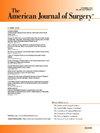Disparities in postoperative adjuvant therapy utilization and factors impacting survival among anaplastic thyroid cancer patients
IF 2.7
3区 医学
Q1 SURGERY
引用次数: 0
Abstract
Background
Anaplastic thyroid cancer (ATC) is highly aggressive with a poor prognosis. Adjuvant systemic therapy and radiation post-surgery are endorsed by NCCN and ATA guidelines. Our study aimed to identify those at risk of forgoing postoperative adjuvant treatment and to determine survival predictors.
Methods
We used the National Cancer Database (NCDB) to identify ATC patients who underwent upfront thyroidectomy from 2010 to 2017, excluding those opting for palliative care. We compared demographics, characteristics, treatments, and outcomes between those who received adjuvant therapy and those who did not. Predictors of receiving adjuvant therapy were identified using logistic regression, while Cox regression identified survival factors.
Results
Of 563 patients, 160 received no adjuvant treatment, 82 received radiation only, 16 received systemic therapy only, and 305 received combination therapy. Notably, over 75 % of patients who did not receive adjuvant treatment had it excluded from their treatment plan, not due to refusal. Older age (OR 0.92) and non-white race/ethnicity (OR 0.33) were significant predictors of not receiving adjuvant therapy. Undergoing a total thyroidectomy, an R0 or R1 resection, and radiation or combination therapy were associated with better survival, while non-metropolitan location, primary tumor size >7.5 cm, and stage IVC disease were negative factors.
Conclusion
Total thyroidectomy, R0/R1 resection, and adjuvant therapy reduce mortality in ATC patients. However, older patients and minorities are less likely to receive adjuvant therapy, underscoring disparities in treatment adherence.
无性甲状腺癌患者术后辅助治疗利用率的差异及影响生存的因素
背景甲状腺非典型癌(ATC)具有高度侵袭性,预后较差。NCCN和ATA指南均认可术后辅助系统治疗和放射治疗。我们的研究旨在识别那些有放弃术后辅助治疗风险的患者,并确定生存预测因素。方法我们利用美国国家癌症数据库(NCDB)识别了2010年至2017年接受前期甲状腺切除术的ATC患者,排除了那些选择姑息治疗的患者。我们比较了接受辅助治疗者和未接受辅助治疗者的人口统计学、特征、治疗方法和结果。结果 在563名患者中,160人未接受辅助治疗,82人仅接受放射治疗,16人仅接受系统治疗,305人接受综合治疗。值得注意的是,在没有接受辅助治疗的患者中,超过 75% 的患者在治疗计划中排除了辅助治疗,而不是因为拒绝。年龄较大(OR值为0.92)和非白人种族/族裔(OR值为0.33)是不接受辅助治疗的重要预测因素。接受甲状腺全切除术、R0或R1切除术、放射治疗或综合治疗与较高的生存率有关,而非城市地区、原发肿瘤大小>7.5厘米和IVC期疾病则是负面因素。然而,年龄较大的患者和少数族裔接受辅助治疗的可能性较低,这凸显了治疗依从性方面的差异。
本文章由计算机程序翻译,如有差异,请以英文原文为准。
求助全文
约1分钟内获得全文
求助全文
来源期刊
CiteScore
5.00
自引率
6.70%
发文量
570
审稿时长
56 days
期刊介绍:
The American Journal of Surgery® is a peer-reviewed journal designed for the general surgeon who performs abdominal, cancer, vascular, head and neck, breast, colorectal, and other forms of surgery. AJS is the official journal of 7 major surgical societies* and publishes their official papers as well as independently submitted clinical studies, editorials, reviews, brief reports, correspondence and book reviews.

 求助内容:
求助内容: 应助结果提醒方式:
应助结果提醒方式:


